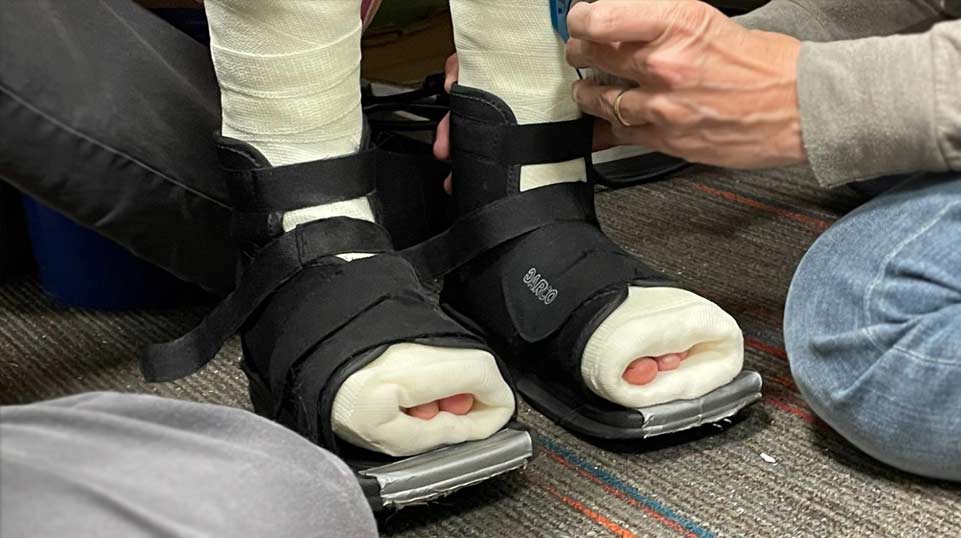Blog

Why Early Intervention is Crucial for Toe Walking
Occupational Therapy, Physical Therapy
Witnessing your child take those first wobbly steps is such an exciting milestone for any parent. As our new walkers gain confidence and speed, exploring their world becomes an adventure. However, you may find yourself worrying if your child is consistently walking on their toes.
In this article, we’ve heard from Shari Cassidy, Founder of Westside Children’s Therapy, on why we need to treat ankle and foot range deficiencies early using serial casting for the benefit of the child’s long-term health and mobility.
Why Do Children Toe Walk?
You may wonder why your child is toe walking. It’s important to know that toe walking always happens for a reason. Over the years, there has been a noticeable increase in the number of children who toe walk, a trend that continues today. While some cases of toe walking can be linked to conditions like cerebral palsy or certain neurological disorders such as muscular dystrophy or spinal cord abnormalities, others are called idiopathic. The so-called idiopathic toe-walking can always be explained with a skilled evaluation. These toe-walkers have postural deficits.
While we don’t know for certain what caused these postural deficits, there seems to be a link to the Back to Sleep campaign and the inequality in the time babies spend on their backs versus the time they spend on their tummies. Insufficient tummy time can result in muscular imbalances between extensor and flexor muscles, delayed or absence of crawling, and weakened strength, which may be related to toe walking down the road.
The Relationship Between Toe Walking and Sensory Differences
You may have heard that toe walking is linked to sensory issues. While sensory tissues can develop when a child’s center of mass is in front of their base of support (such as the inability to stand still), it’s essential to understand that treating sensory concerns alone, such as through Occupational Therapy, does not directly address toe walking.
Toe walking is a postural issue with extensor muscles working greater than the flexor muscles. This imbalance results in the child’s center of mass moving forward in front of their base of support. These postural and muscular imbalances need correction or the toe-walking will progress and lead to range deficiencies in the foot and ankle, as well as asymmetries up the chain. Therefore, while sensory interventions are beneficial for overall development, addressing the underlying postural issues are the only way to resolve toe walking.
Do Children Grow Out of Toe Walking?
You may have heard that children grow out of toe walking. Many pediatricians still relay this belief to parents. However, the reality is that children who demonstrate center of mass in front of their base of support will never grow out of toe walking – they will grow into it.
Your child’s toe-walking isn’t just a phase they’ll naturally outgrow.
Toe walking can worsen over time, leading to muscle and bone deformities that require more intensive treatment. Think about it: misaligned teeth can’t magically correct themselves without intervention. The same goes for toe-walking—it’s not something your child will simply outgrow.
The Importance of Early Intervention with Toe Walking
Early intervention is key here. Children who consistently toe walk not only have flexor/extensor imbalances but they also have left/right imbalances as well. They always have a dominant weight-bearing leg. This asymmetry can cause bones to grow abnormally with twisting of the legs, pelvis, and spine. As children grow, these asymmetries tend to progress causing further alignment and postural deficiencies.
This lack of balanced musculature around a joint will result in a decreased range of motion. When range is lacking, there will be an increased risk of injury, especially, when the child is very physically active.
Research by Baumbach, highlights the importance of ankle flexibility, particularly in sports participation. A study focusing on 10-17-year-old basketball players found that limited ankle dorsiflexion (less than 30 degrees) increased the risk of common injuries to the knees and ankles. Therefore, addressing toe walking early not only corrects gait abnormalities and postural asymmetries, but it also promotes normal skeletal growth and reduces the risk of future injuries.
Treating toe walking as soon as it is recognized is a much shorter and easier process than waiting until the child is older. When treated early we can avoid skeletal incongruencies and growth deformities and we can begin the work of strengthening the weak muscles just by correcting the way the child walks. Correcting toe walking in a 2-year-old child may take as little as three weeks, while the process could extend to 6-12 months for a 12-year-old. The longer you wait to address toe walking, the more challenging it becomes to correct.
Serial Casting: An Intervention for Toe Walking
Serial casting is a non-invasive method used to improve joint range of motion for a variety of diagnoses, including toe walking. Over time, toe walking causes severe connective tissue stiffness and contracture of the muscles in the foot and the ankle.
Once the foot and ankle are contracted, serial casting or surgery are the most suggested treatments. Because there are 26 bones within the foot that are not addressed with a surgical Achilles lengthening, we recommend serial casting so we can place the bones within the foot in their proper positions. Furthermore, a child’s postural deficits, muscular imbalances, and asymmetries are not treated with surgery alone. When done correctly, serial casting can fix toe walking without cutting a child’s muscle and weakening that muscle for the rest of the child’s life. Serial casting is a safer and less expensive option that maximizes the medical outcomes for your child.
The Process of Serial Casting
At Westside, we begin with a free screening that answers all of your questions and provides an estimate of casting length of time based on the child’s age, stiffness, and range deficits. Next, you will have an initial appointment where we will review your child’s full medical history, as well as conduct a posture assessment. We will take pictures and videos for our records. Then, we will take ankle and foot measurements prior to putting the casts on. Your child will start walking with a heel strike on day one of casting.
From that point forward, each weekly appointment will consist of cast changes and measurements on each affected ankle. When the casting process is complete, children will wear an ankle foot orthotic (AFO) to help retrain their muscles and make sure they don’t slip back into old habits. It is highly recommended that physical therapy happens during this time to help your child strengthen weakened muscles and to work on proper gait mechanics..
The End Result
Serial casting allows your kid to still be a kid. They are encouraged to be active and play. During the casting process, the child is going to begin to form a new habit of walking with the heel striking the floor first. The more steps a child takes with a heel strike, the faster the range comes back.
The earlier the process begins, the quicker it is to complete, giving your child a full range of mobility and allowing them to begin moving with normal movement patterns for age. Early treatment will prevent asymmetries and bony malalignments from progressing.
If you have more questions about serial casting, call 815-469-1500, and we will be happy to walk you through the process.




